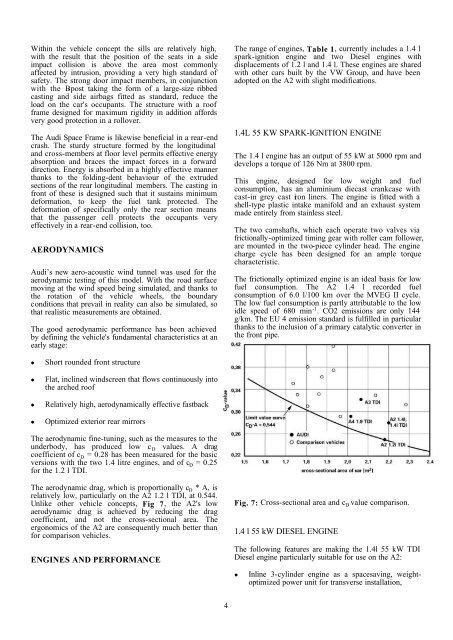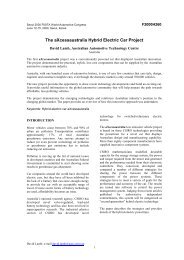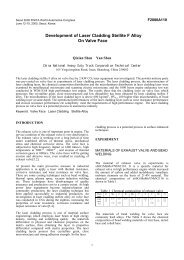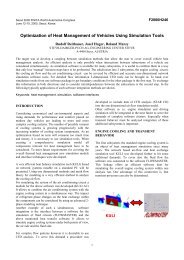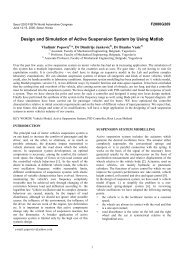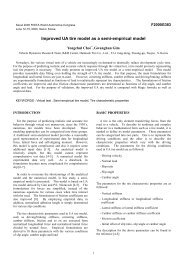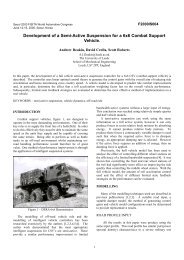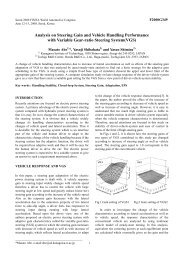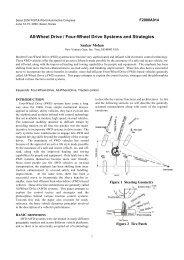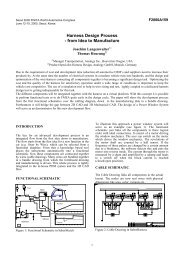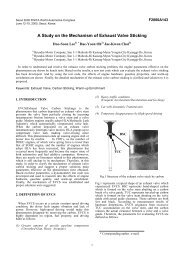A New Innovative Automobile Concept in the Compact Car Class
A New Innovative Automobile Concept in the Compact Car Class
A New Innovative Automobile Concept in the Compact Car Class
Create successful ePaper yourself
Turn your PDF publications into a flip-book with our unique Google optimized e-Paper software.
With<strong>in</strong> <strong>the</strong> vehicle concept <strong>the</strong> sills are relatively high,with <strong>the</strong> result that <strong>the</strong> position of <strong>the</strong> seats <strong>in</strong> a sideimpact collision is above <strong>the</strong> area most commonlyaffected by <strong>in</strong>trusion, provid<strong>in</strong>g a very high standard ofsafety. The strong door impact members, <strong>in</strong> conjunctionwith <strong>the</strong> B-post tak<strong>in</strong>g <strong>the</strong> form of a large-size ribbedcast<strong>in</strong>g and side airbags fitted as standard, reduce <strong>the</strong>load on <strong>the</strong> car's occupants. The structure with a roofframe designed for maximum rigidity <strong>in</strong> addition affordsvery good protection <strong>in</strong> a rollover.The Audi Space Frame is likewise beneficial <strong>in</strong> a rear-endcrash. The sturdy structure formed by <strong>the</strong> longitud<strong>in</strong>aland cross-members at floor level permits effective energyabsorption and braces <strong>the</strong> impact forces <strong>in</strong> a forwarddirection. Energy is absorbed <strong>in</strong> a highly effective mannerthanks to <strong>the</strong> fold<strong>in</strong>g-dent behaviour of <strong>the</strong> extrudedsections of <strong>the</strong> rear longitud<strong>in</strong>al members. The cast<strong>in</strong>g <strong>in</strong>front of <strong>the</strong>se is designed such that it susta<strong>in</strong>s m<strong>in</strong>imumdeformation, to keep <strong>the</strong> fuel tank protected. Thedeformation of specifically only <strong>the</strong> rear section meansthat <strong>the</strong> passenger cell protects <strong>the</strong> occupants veryeffectively <strong>in</strong> a rear-end collision, too.AERODYNAMICSAudi’s new aero-acoustic w<strong>in</strong>d tunnel was used for <strong>the</strong>aerodynamic test<strong>in</strong>g of this model. With <strong>the</strong> road surfacemov<strong>in</strong>g at <strong>the</strong> w<strong>in</strong>d speed be<strong>in</strong>g simulated, and thanks to<strong>the</strong> rotation of <strong>the</strong> vehicle wheels, <strong>the</strong> boundaryconditions that prevail <strong>in</strong> reality can also be simulated, sothat realistic measurements are obta<strong>in</strong>ed.The good aerodynamic performance has been achievedby def<strong>in</strong><strong>in</strong>g <strong>the</strong> vehicle's fundamental characteristics at anearly stage:The range of eng<strong>in</strong>es, Table 1, currently <strong>in</strong>cludes a 1.4 lspark-ignition eng<strong>in</strong>e and two Diesel eng<strong>in</strong>es withdisplacements of 1.2 l and 1.4 l. These eng<strong>in</strong>es are sharedwith o<strong>the</strong>r cars built by <strong>the</strong> VW Group, and have beenadopted on <strong>the</strong> A2 with slight modifications.1.4L 55 KW SPARK-IGNITION ENGINEThe 1.4 l eng<strong>in</strong>e has an output of 55 kW at 5000 rpm anddevelops a torque of 126 Nm at 3800 rpm.This eng<strong>in</strong>e, designed for low weight and fuelconsumption, has an alum<strong>in</strong>ium diecast crankcase withcast-<strong>in</strong> grey cast iron l<strong>in</strong>ers. The eng<strong>in</strong>e is fitted with ashell-type plastic <strong>in</strong>take manifold and an exhaust systemmade entirely from sta<strong>in</strong>less steel.The two camshafts, which each operate two valves viafrictionally-optimized tim<strong>in</strong>g gear with roller cam follower,are mounted <strong>in</strong> <strong>the</strong> two-piece cyl<strong>in</strong>der head. The eng<strong>in</strong>echarge cycle has been designed for an ample torquecharacteristic.The frictionally optimized eng<strong>in</strong>e is an ideal basis for lowfuel consumption. The A2 1.4 l recorded fuelconsumption of 6.0 l/100 km over <strong>the</strong> MVEG II cycle.The low fuel consumption is partly attributable to <strong>the</strong> lowidle speed of 680 m<strong>in</strong> -1 . CO2 emissions are only 144g/km. The EU 4 emission standard is fulfilled <strong>in</strong> particularthanks to <strong>the</strong> <strong>in</strong>clusion of a primary catalytic converter <strong>in</strong><strong>the</strong> front pipe.• Short rounded front structure• Flat, <strong>in</strong>cl<strong>in</strong>ed w<strong>in</strong>dscreen that flows cont<strong>in</strong>uously <strong>in</strong>to<strong>the</strong> arched roof• Relatively high, aerodynamically effective fastback• Optimized exterior rear mirrorsThe aerodynamic f<strong>in</strong>e-tun<strong>in</strong>g, such as <strong>the</strong> measures to <strong>the</strong>underbody, has produced low c D values. A dragcoefficient of c D = 0.28 has been measured for <strong>the</strong> basicversions with <strong>the</strong> two 1.4 litre eng<strong>in</strong>es, and of c D = 0.25for <strong>the</strong> 1.2 l TDI.The aerodynamic drag, which is proportionally c D * A, isrelatively low, particularly on <strong>the</strong> A2 1.2 l TDI, at 0.544.Unlike o<strong>the</strong>r vehicle concepts, Fig 7, <strong>the</strong> A2's lowaerodynamic drag is achieved by reduc<strong>in</strong>g <strong>the</strong> dragcoefficient, and not <strong>the</strong> cross-sectional area. Theergonomics of <strong>the</strong> A2 are consequently much better thanfor comparison vehicles.ENGINES AND PERFORMANCEFig. 7: Cross-sectional area and c D value comparison.1.4 l 55 kW DIESEL ENGINEThe follow<strong>in</strong>g features are mak<strong>in</strong>g <strong>the</strong> 1.4l 55 kW TDIDiesel eng<strong>in</strong>e particularly suitable for use on <strong>the</strong> A2:• Inl<strong>in</strong>e 3-cyl<strong>in</strong>der eng<strong>in</strong>e as a spacesav<strong>in</strong>g, weightoptimizedpower unit for transverse <strong>in</strong>stallation,4


